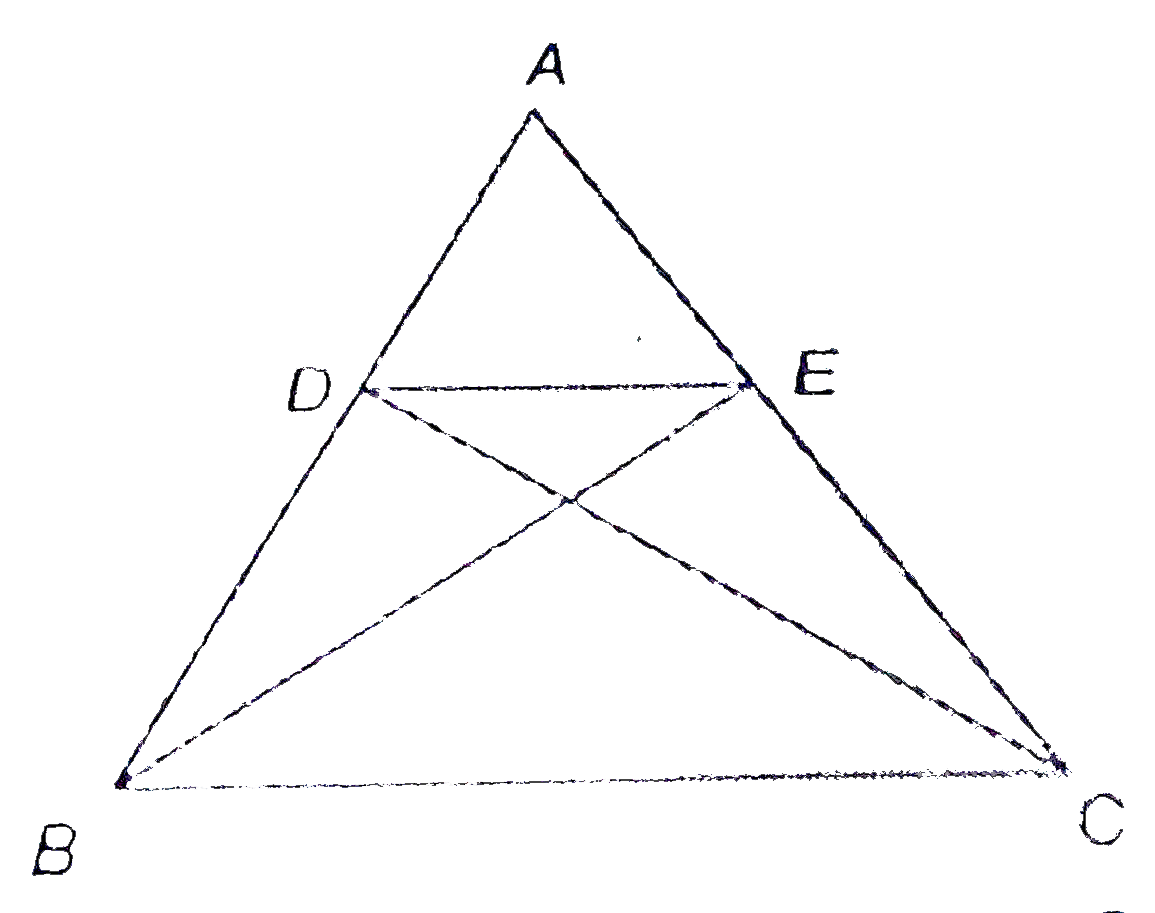D and E are points on sides AB and AC respectively of ΔABC such that ar(ΔDBC) = ar(ΔEBC). Prove that DE I I BC.
To prove that line segment DE is parallel to line segment BC in triangle ABC, given that the areas of triangles DBC and EBC are equal, we can follow these steps:
1. Understand the Given Information:
We have triangle ABC with points D and E on sides AB and AC respectively. We are given that the area of triangle DBC is equal to the area of triangle EBC.
2. Write Down the Area Condition:
We know that:
ar(ΔDBC)=ar(ΔEBC)
3. Identify the Common Base:
Both triangles DBC and EBC share the same base BC.
4. Use the Area Formula:
The area of a triangle can be expressed as:
Area=12×base×height
For triangles DBC and EBC, we can express their areas as:
ar(ΔDBC)=12×BC×hD
ar(ΔEBC)=12×BC×hE
where hD and hE are the heights from points D and E to line BC respectively.
5. Set the Area Equations Equal:
Since the areas are equal, we can set the two area equations equal to each other:
12×BC×hD=12×BC×hE
6. Simplify the Equation:
Since BC is the same in both equations and is not equal to zero, we can divide both sides by 12×BC:
hD=hE
7. Interpret the Heights:
The equality hD=hE means that the perpendicular distances from points D and E to line BC are equal.
8. Conclude the Parallelism:
Since D and E are at the same height from line BC, by the properties of parallel lines, we can conclude that line DE is parallel to line BC:
DE∥BC
Final Statement:
Thus, we have proved that DE is parallel to BC.
---
We have triangle ABC with points D and E on sides AB and AC respectively. We are given that the area of triangle DBC is equal to the area of triangle EBC.
We know that:
ar(ΔDBC)=ar(ΔEBC)
Both triangles DBC and EBC share the same base BC.
The area of a triangle can be expressed as:
Area=12×base×height
For triangles DBC and EBC, we can express their areas as:
ar(ΔDBC)=12×BC×hD
ar(ΔEBC)=12×BC×hE
where hD and hE are the heights from points D and E to line BC respectively.
Since the areas are equal, we can set the two area equations equal to each other:
12×BC×hD=12×BC×hE
Since BC is the same in both equations and is not equal to zero, we can divide both sides by 12×BC:
hD=hE
The equality hD=hE means that the perpendicular distances from points D and E to line BC are equal.
Since D and E are at the same height from line BC, by the properties of parallel lines, we can conclude that line DE is parallel to line BC:
DE∥BC
Thus, we have proved that DE is parallel to BC.
Topper's Solved these Questions
- AREAS OF PARALLELOGRAMS AND TRIANGLESBOOK - MTG IIT JEE FOUNDATIONCHAPTER - AREAS OF PARALLELOGRAMS AND TRIANGLESEXERCISE - NCERT SECTION ( EXERCISE 9.4)
19 Videos
- AREAS OF PARALLELOGRAMS AND TRIANGLESBOOK - MTG IIT JEE FOUNDATIONCHAPTER - AREAS OF PARALLELOGRAMS AND TRIANGLESEXERCISE - EXERCISE ( Multiple Choice Questions )
45 Videos
- AREAS OF PARALLELOGRAMS AND TRIANGLESBOOK - MTG IIT JEE FOUNDATIONCHAPTER - AREAS OF PARALLELOGRAMS AND TRIANGLESEXERCISE - NCERT SECTION ( EXERCISE 9.2)
7 Videos
- CIRCLES BOOK - MTG IIT JEE FOUNDATIONCHAPTER - CIRCLES EXERCISE - OLYMPIAD/HOTS CORNER
6 Videos
Similar Questions
Knowledge Check
In ΔABC, D and E are two points on the sides AB and AC respectively so that DE || BC and ADBD=23. Then the area of trapezium DECBthe area of ΔABCequa to
A59B2125C145D514In ΔABC,D and E are the points on sides AB and BC respectively such that DE || AC. If AD : DB = 5 : 3, then what is the ratio of the area of ΔBDE to that of the trapezium ACED ?
A1:6B4:25C9:55D9:64If D, E and F are the mid-points of sides BC, CA and AB respectively of △ABC, then the ratio of the areas of △DEF to the area of △ABC is :
A1:4B1:2C1:3D2:3
The points D and E are respectively located on AB and AC on the sides of ΔABC such that ar(DBC)=ar(EBC). Demonstrate thatDE∣∣BC.
View SolutionIn △ABC, D and E are points on the sides AB and AC,respectively, such that DE|| BC and DE : BC = 6 : 7, (Area of △ADE) : (Area of trapezium BCED) =?
△ABC में, D और E, क्रमशः AB और AC पर बिंदु हैं, जैसे कि DE ||BC और DE : BC = 6 : 7, ( △ADE का क्षेत्रफल ): (समलम्ब BCED का क्षेत्रफल ) = ?
View SolutionIn △ABC ,D and E are the points on sides AB and AC, respectively, such that DE || BC. If DE : BC is 3 : 5, then (Area of △ADE): (Area of quadrilateral DECB) is:
त्रिभुज ABC में, D तथा E भुजा AB और AC पर स्थित ऐसे बिंदु हैं कि DE || BC है | यदि DE : BC= 3 : 5, है, तो (△ADE का क्षेत्रफल ): ( DECB का क्षेत्रफल ) ज्ञात करें |
View SolutionIn △ABC, D and E are the points on sides AB and BC respectively such that DE || AC. If AD : DB = 5 : 3, then what is the ratio of the area of △BDE to that of the trapezium ACED?
View SolutionD and E are points on sides AB and AC of ΔABC. DE is parallel to BC. If AD : DB = 1 : 2 and area of ΔABC is 45 sq. cm., what is the area (in sq. cm.) of quadrilateral BDEC ?
View Solution


